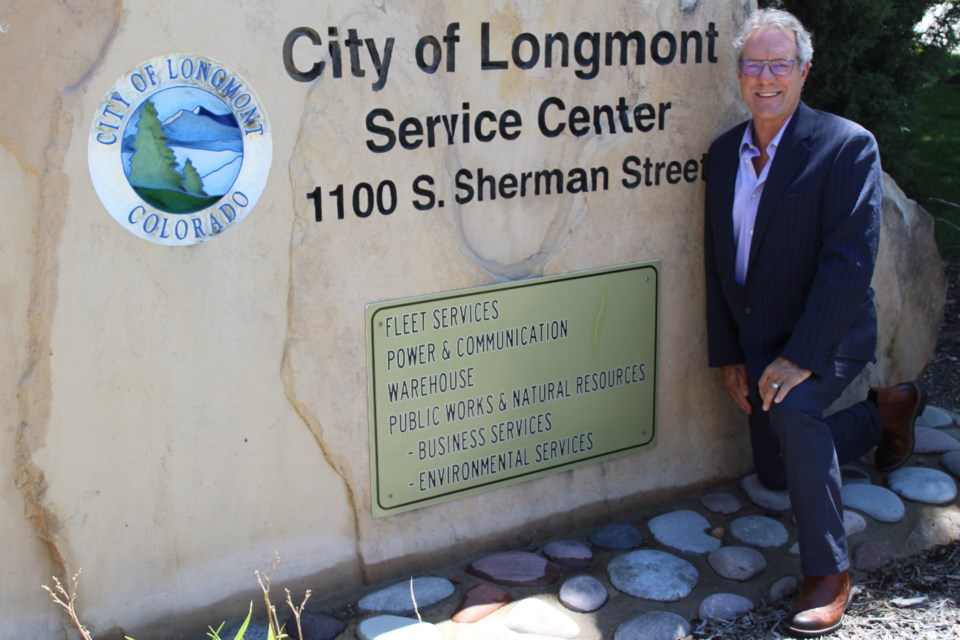This content was originally published by the Longmont Observer and is licensed under a Creative Commons license.
Written by Isaac Furtney
David Hornbacher is the newly hired director of Longmont Power and Communications Electric Department.
Previously, Susan Wisecup headed both the electric and broadband utilities. The two utilities have been separated and Valerie Dodd will take over the broadband portion.
Hornbacher brings 35 years of utility experience to the role, including working with Longmont in the past. Other places Hornbacher has worked include: Colorado Springs, Denver, Boulder, and Aspen. He has worked for both public and private utility organizations but said he prefers public utilities because their responsibility to the community they serve aligns with his values of trying to make a positive difference every day for both the community and the staff of the organization he works for.
Aside from managing electric utilities, Hornbacher has also managed water and gas utilities. He began his career in water utilities in the wastewater sector, but after developing relationships with those in the electric utility, he found their excitement to be contagious. This drove him to supplement his education and move his career in that direction.
“Electricity is fun,” Hornbacher said, “It touches everything we do…the cell phone you charge, the lights you turn on, the dinner you cook, heating, charging an electric car…it’s the basis for [modern] life.”
Longmont receives its power from the Platte River Power Authority (PRPA) which also provides energy to the communities of Loveland, Fort Collins, and Estes Park. Hornbacher lauded LPC’s reliability in its 107-year history, as well as its current status as providing the second-lowest residential rates in Colorado out of the 57 electrical utility organizations that serve the state.
Most recently, Hornbacher managed Aspen’s water and electric utilities and helped the town to achieve the transition to 100% renewable energy generation—a goal LPC has accepted to achieve by the year 2030. He explained that Aspen is a place that well-illustrates the effects of man-made climate change, as the annual average number of frost-free days in the town has declined by 34 days since the 1950s, negatively impacting the community’s snow-based tourism.
When Hornbacher learned of the opportunity in Longmont, he jumped on it. He is excited to focus on electric utility alone. “Longmont is an exceptional organization between its people and its mission.” He described this mission as three-fold: to supply reliable, affordable, and clean power to the community of Longmont.
To achieve the goal of 100% renewably generated energy by 2030—which Hornbacher was emphatic that LPC will achieve—he outlined three major components: 1) Never losing sight of conservation and efficiency programs that help manage the electric load and provide actions for customers to do daily, 2) the partnerships, such as the one with the PRPA, which are unified in their commitment towards that goal, and 3) projects of additional renewable energy production, as in the construction and development of local solar plants and wind farms. The city has also required an interim goal of reaching 50% non-carbon producing energy generation by 2022, which LPC is on track to beat by a full year.
Hornbacher said that Longmont has many advantages when it comes to transitioning to 100% renewable energy generation as well as at least three challenges. First, he named that the LPC public utility is just a part of a group that includes three other cities in PRPA that are just as committed to converting to renewable energy production.
He then expressed that LPC’s history of being well-managed and providing high reliability and low rates positions the utility to transition well and that renewables and access to them have evolved to be less expensive and more dispatchable, meaning they can be used on-demand according to market needs.
The challenges he said are that such a transition is, by definition, large-scale and complex, and maintaining rates and reliability makes it even more difficult. He wants LPC to drive technology development and work with vendors and researchers to lead the way in this endeavor and to both set an example and be a point of inspiration for other communities to set similar goals. He mentioned that LPC’s Nextlight division has already done this with its fiber-optic broadband internet service.
Hornbacher said that reducing Longmont’s carbon footprint is a goal he champions. He explained that electric power generation is only one element of reducing a community’s carbon footprint and that other choices, such as transportation, play an important role.
Along that line, Longmont’s four city-operated electric vehicle charging stations are being upgraded to accommodate eight vehicles instead of four and will charge at level-two charging capacity which can fully charge an electric vehicle’s battery 4-5 times faster than a level-one charger. He also pointed out that Nextlight allows some people to work from home, eliminating carbon emissions from vehicles normally created by commuting.
He discussed LPC’s commitment to helping qualified participants with their utility expenses via conservation efficiency on a consumer level, which involves such things as using the latest energy conservation technology, such as Advanced Metering Infrastructure (AMI), smart thermostats and LED lightbulbs. He explained that AMI can provide data about a household’s or business’ electricity usage every fifteen minutes, as opposed to the current technology’s once-per-month readings. This can help consumers learn how and when they use electricity so they can reduce usage and improve the partnership between the utility and its consumers/owners.
Hornbacher is excited to be a part of LPC’s electric utility and will use his energy knowledge to work with his “exceptional” staff to ensure the utility achieves the goals and direction it has set.



